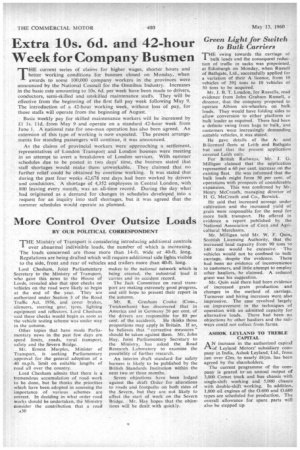Green Light for Switch to Bulk Carriers
Page 32

If you've noticed an error in this article please click here to report it so we can fix it.
THE swing towards the carriage of bulk loads and the consequent reduction of traffic in sacks was pinpointed. at Edinburgh on Monday, when Russell of Bathgate, Ltd., successfully applied for a variation of their A licence, from 10 vehicles of 39i tons to 10 vehicles of 50 tons to be acquired.
Mr. J. B. T. Loudon, for Russells, read evidence from John Graham Russell, a director, that the company proposed to operate Albion six-wheelers on bulk, loads. They would have folding sides to allow conversion to either platform or hulk loader as required. There had been a definite swing from bags to bulk, and customers were increasingly demanding suitable vehicles, it was stated.
He gave details of the Aand B-licensed fleets at Leith and Bathgate but said that the present application covered Leith only.
For British Railways, Mr. J. G. Milligan claimed that the application represented a 60 per cent, increase on the existing fleet. He was informed that the bulk loads might form 50 per cent, of operations with prospects of considerable expansion, This was confirmed by Mr. Henry McCreath, managing director of H. G. McCreath and Co., Berwick.
He said that increased acreage under cultivation and the increased yield of grain were responsible for the need for more bulk transport. He offered in evidence a report published by the National Association of Corn and Agricultural Merchants.
Mr. Milligan told Mr. W. F. Quin, Scottish Licensing Authority, that the increased load capacity from 90 tons to 140 tons would be excessive. The vehicles would not be confined to bulk carriage, despite the evidence. There had been no evidence . of inconvenience to customers, and little attempt to employ other hauliers, he claimed. A reduced, grant was his suggestion.
Mr. Quin said there had been evidence of increased grain production and changes in the method of carriage. Turnover and hiring increases were also impressive. The case revolved largely on improvement in the techniques of operation with an admitted capacity for alternative loads. There had been no objections by other hauliers and the railways could not collect from farms.
ASHOK LEYLAND TO TREBLE CAPITAL
AN increase in the authorized capital of Leyland Motors' subsidiary company in India, Ashok Leyland, Ltd., from just over £2m, to nearly .661m. has been agreed by the shareholders.
The current programme of the company is geared toan annual output of 3,000 Comet truck and bus chassis with single-shift working and 5,000 chassis with double-shift working. In addition, 1,000 oil engines of the 0.600 and 0.680 types are scheduled for production. The overall allowance for spare parts will also be stepped up,




































































































